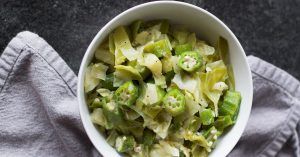Fruits and Vegetables You Haven’t Tried

Do you tire of eating the same fruits and vegetables? Do you want to switch things up and try something new? The 100 Year Lifestyle is all about uncovering new food options to incorporate into your everyday diet that are nutritious and delicious. Humans should try to eat anywhere from five to nine servings of fruits and vegetables per day in order to ensure a longer, healthier lifestyle. Here are some fruits and vegetables that you probably haven’t tried:
Cherimoya (fruit)
This fruit is native to Colombia, Ecuador, Peru, Bolivia and Chile, as well as the Andes and Central America. Its flavor ranges from mellow sweet to tangy or acidic sweet, with hints of pineapple, banana, pear, papaya, strawberry or other berry, and apple, depending on the variety. It’s mostly grown in tropical regions and is high in vitamin B6, C, and dietary fiber.
Mark Twain once referred to it as “the most delicious fruit known to men.”
Okra (vegetable)
The exact origins of okra is still disputed, but it some people believe it to be Ethiopian, West African, or even South Asian. It’s prevalent in the southeastern United States today, cooked into gumbo or served cooked by itself. Raw okra is 90 percent water, two percent protein, seven percent carbohydrates and negligible in fat. In a 100 gram amount, raw okra is rich in dietary fiber, vitamin C and vitamin K. You can cook, pickle, serve it raw, in salads, or stuff it with something.
Pitaya (fruit)
More commonly known as a dragon fruit thanks to its scaly-looking skin, bright colors, and spikes, pitaya is a fruit cultivated in Southeast Asia, Florida, the Caribbean, Australia, and throughout tropical and subtropical world regions. People often likened it to that of a kiwifruit due to its black, crunchy seeds. With white flesh, it’s mostly bland with a little bit of sweetness and low in calories. It’s got 11 percent of the Daily Value for vitamin C and calcium.
Rutabaga (vegetable)
Rutabaga is a root vegetable that originated as a cross between the cabbage and the turnip. People consider its origination in Scandinavia or Russia. You can roast, bake, broil, boil, use as a flavor enhancer in soups, or thinly julienne them as a side dish or in a salad. Bitter in taste and rich in vitamin C, they are a great vegetable to add into your diet.
African Cucumber (fruit)
A uniquely beautiful fruit, it has orange skin and lime green flesh with a refreshingly fruity taste, and texture similar to a passionfruit or pomegranate. It originated in sub-Saharan Africa. We now grow it in the United States, Portugal, Italy, Germany, Chile, Australia, and New Zealand. Its taste is a mix of banana and passionfruit, even with hints of cucumber and lime. This is a fruit rich in vitamin C and magnesium.
These are just a few of the hundreds of exotic fruits and vegetables, and even though you might not get to try them all throughout your lifetime, try new things when you can. Eating foods that are rich in vitamins and overall healthy for you can improve your nutritional intake and make your food more exciting. Living your best 100 Year Lifestyle includes cutting unhealthy foods out of your diet. Consider switching them out for these fruits and vegetables instead.
- SHARE THIS POST







